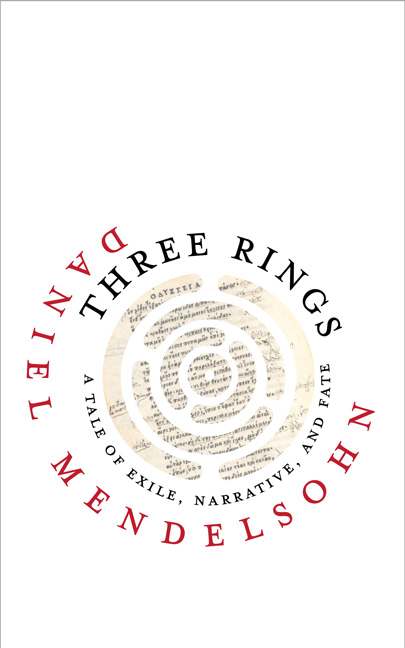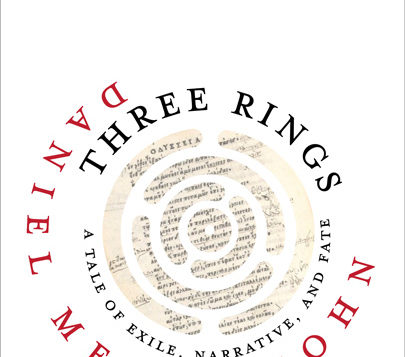 THREE RINGS
THREE RINGS
A Tale of Exile, Narrative, and Fate
by Daniel Mendelsohn
Univ. of Virginia. 116 pages, $19.95
TO BEGIN, let’s circle back to an earlier book by Daniel Mendelsohn, An Odyssey: A Father, a Son, and an Epic, an engaging account of the semester he invited his 81-year-old father to attend his seminar on Homer’s epic poem. That book, which I highly recommend, is not only a brilliant reading of Homer but also the story of a contemporary father and son rediscovering each other. In the end, Mendelsohn, who had “vainly envisioned myself as some kind of pedagogical Odysseus,” learned as much from his father as his father learned from him. “You never know, really, where education will lead, who will be listening and, in certain cases, who will be doing the teaching.”
Mendelsohn begins his new book with an account of the difficulty he had in writing the previous one. As he was drafting An Odyssey, he labored under “narrative despair”: “I had no idea how to organize the story. … There was a lot of incident but it wasn’t yet a story.” The solution he hit upon was to adopt a narrative technique—so-called “ring composition”—that Homer himself employed. In ring composition, the writer “involutes” narrative digressions into the larger story line, eventually tying together these twists and turns into the overall action of the story. These detours, Mendelsohn says, “can enhance rather than detract from a given theme.” Indeed, “the way to avoid boring uniformity is to add more and more turns.”
Mendelsohn’s new book is an over-the-top celebration of ring composition.
He structures this hundred-page essay (originally delivered at UVA’s Page-Barbour Lectures) around three literary exiles. He follows these wanderers along their battered journeys in search of a place of refuge. Like Odysseus and his son Telemachus, each of the three managed to find a home of sorts after fleeing cultural, political, and existential dangers.
As he tells their stories, Mendelsohn takes us along ever more divergent paths. A biographical detail often triggers what at first seems like a random fact or far-off association, unrelated to the main thread. And off we go, spinning, wandering, meandering through a fascinating chain of other stories and pieces of information, until—presto!—he snaps everything into place, revealing the deep connections between seemingly disparate details. The effect is ingenious and caused me to burst into delighted laughter on more than one occasion.
The first of Mendelsohn’s wanderers is the cosmopolitan German literary scholar Erich Auerbach, who fled Nazi Germany in 1936. He relocated to Istanbul, where he wrote his magnum opus Mimesis: The Representation of Reality in Western Literature. Auerbach’s stunning book, which sought to trace “the common connectedness of all cultures,” amasses literary evidence to demonstrate, as Mendelsohn says, that “certain realities are, in the end, shared by all humans,” adding that, “although literature consists of a Babel of different tongues, meaning is universal, and a unity exists beyond all cultural diversity … the communal connectedness of cultures.” At least, this was the optimistic belief that Auerbach held until, in writing Mimesis, he adopted a more pessimistic, “biblical,” viewpoint, holding that we are for the most part granted only a fragmentary understanding of things based upon our cultural perspective. The whole of civilization is not knowable.
The second literary exile is the 17th-century French archbishop and theologian, François Fénelon, who penned a series of instructive tales, The Adventures of Telemachus, an imaginative extension of Homer’s original epic. Fénelon had been commissioned to educate the future king of France, the son of Louis XIV, on the virtues a good king must possess. The book is a critique of the dangers of greed, egotism, dishonesty, and erotic indulgence—in effect, a none-too-subtle critique of the Sun King himself. Louis figured it out and sent Fénelon packing to a dreary diocese in the north of France.
Mendelsohn’s third subject is the writer W. G. Sebald, who in the postwar years left his native Germany—out of “claustrophobic shame”—and spent the rest of his life teaching and writing in England. Sebald’s themes, like Homer’s, concern emigration, wandering, flight, and exile. The Rings of Saturn, one of his most acclaimed novels, “consists of nothing but digressions,” Mendelsohn says, “a series of tales that both describe and mirror its narrator’s meandering walks.” Unlike the narrative digressions in Homer, the twisting narratives in The Rings of Saturn “lead only to dissolution and defeat.” “The circling merely exhausts us while never bringing us any closer to the subject.”
At this point, Mendelsohn inserts yet another of his many apparent digressions, the gay French novelist Marcel Proust, who was a virtuoso of ring composition. In Proust, he says, the ring “appears to us as a container, filled with all human experience,” whereas in Sebald it embraces a void, “a destination to which, as in some narrative version of Zeno’s paradox, no amount of writing can deliver us.” We are left with nothing but language’s inability “to preserve or rescue or re-create what is no longer present.”
How Mendelsohn ties these three disparate literary exiles together and, in the process, all the many widely wandering excursions he entertains along the way is part of the enormous intellectual pleasure of this book. Want to know the connections between Thomas Jefferson, Racine, and Grand Vizier Kâmil Pasha? Read this book.
But why, a friend asked me, would any of this interest the readers of an LGBT magazine? It’s a fair question. The immediate answer is that Mendelsohn is an openly gay writer and the translator of Constantine Cavafy, the glorious 20th-century Greek poet of gay love and desire. But my friend’s question got me thinking about other, deeper ways in which Mendelsohn’s new book might appeal specifically to this readership.
Is it possible to argue that LGBT people experience themselves as exiles, or at least wanderers, in an alien world, a world where the prevailing cultural norms do not necessarily speak to them and in some cases prove downright dangerous? And could we say, then, that the life project of LGBT people often takes one of two paths? One path leads to discovering a common humanity amid the seemingly alien landscape we find ourselves in. The other path leads to an acceptance of our permanent estrangement from the home that most others have made of the world.
“Beauty and pleasure are at the center of teaching,” Mendelsohn observed in An Odyssey. “For the best teacher is the one who wants you to find meaning in the things that have given him pleasure, too.” Mendelsohn’s latest book achieves just that. Three Rings is not a book for everyone. But for readers who can’t help pondering how we make meaning of the motley mosaic of life, it is a delightful odyssey.
Philip Gambone, a regular contributor to these pages, is the author of the recently published As Far As I Can Tell: Finding My Father in World War II (Rattling Good Yarns Press).






